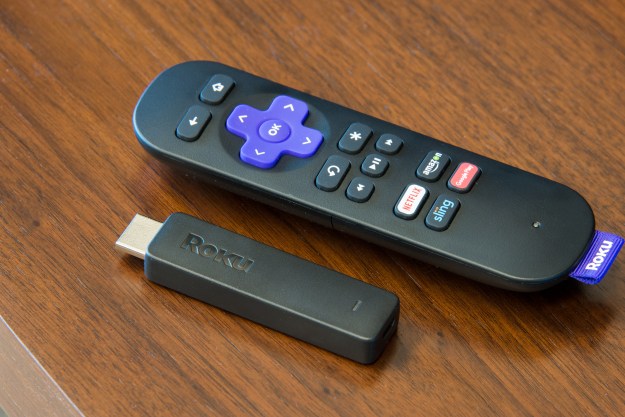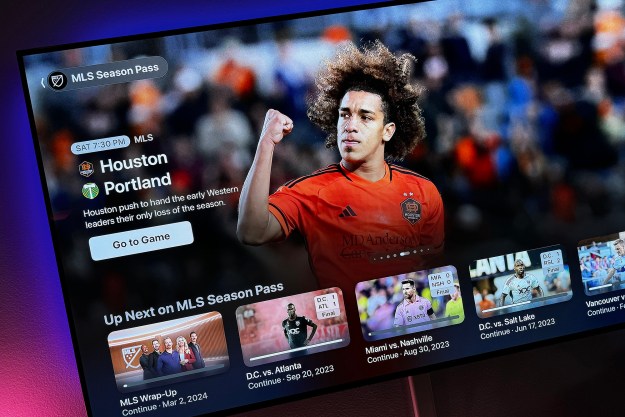Roku Streaming Stick (2016)
MSRP $49.99
“The $50 Roku Streaming Stick is a no-brainer, must-own device for the serious streamer.”
Pros
-
Lightning quick
-
Wireless audio through smart phones
-
All the apps
-
Doesn’t favor any one streaming service
-
Best search around
Cons
-
No 4K support
-
No HDMI extension
It’s hard to believe the original Roku Streaming stick was introduced back in 2014. Time flies when you’re binge-watching Netflix! But here we are, and it’s about time the Roku Stick got an update. With competition from the Amazon Fire TV Stick and Google’s Chromecast heating things up, Roku needed to step up its game a little. But where do you go when you already have one of the best little media streamers on the market?
Well, in the electronics world, you make it faster, sleeker, and cleverer. And that’s what Roku has done. There wasn’t a ton of room for Roku’s Streaming Stick to grow – in fact, physically growing would be a step in the wrong direction – but it did grow up a little. This little stick is quick, and it’s got some fun features you won’t find elsewhere.
In short: Unless you need 4K, external storage, or the ability to play media off a USB thumb drive, the $50 Roku Streaming Stick is a no-brainer, must-own device for the serious streamer.
Out of the box
The beauty of the Roku Streaming Stick is in its simplicity. Therefore, there’s not a ton in the simple, green packaging the device comes in. When you lift the box lid, however, you will be surprised by the Roku Streaming Stick’s waifish profile. It’s much more slender than before, albeit a touch longer. The stick is also matte black rather than purple now, which makes it look a little less cartoonish.
The included remote control has also been slimmed down, and transitioned from glossy to matte black. On the down side, the remote still wobbles around on flat, hard surfaces (an annoyance for this reviewer) but on the plus side, Roku wised up and placed the ‘OK’ button back in the center of the directional pad, making it feel much more familiar to pretty much every other remote control in your house.
We had hoped Roku would lengthen the USB power cable for this iteration, but the company decided to keep it to about 6 feet, and put a right angle on the micro-USB end. The shorter cord works well for connecting the device to a TV’s USB port, but not so well for reaching a power outlet with the included wall adapter.
We also wish Roku included an HDMI extension dongle. This is something Amazon and Google get right. The Streaming Stick barely fits in a Vizio M-Series TV, due to the TV’s HDMI port placement and the cabinetry around them. Fortunately, we had an extra one laying around.
Specs and features
Roku claims its new stick has more processing power than any other pocket-sized streamer, and we’re inclined to agree. The previous Roku streaming stick had a single-core processor, but the Streaming Stick sports a quad-core – just like the Roku 4 — and the performance differences are apparent. The small stick also packs an 802.11 a/b/g/n dual-band antenna.
It actually feels faster than our Roku 4.
What you don’t get is 4K resolution, expandable storage, an Ethernet connection, or the ability to play media stored on USB drives.
Perhaps the most notable new feature for the Roku Streaming Stick is its ability to stream audio to the Roku app installed on any iOS or Android smartphone connected to the same network. While the larger Roku 4 and Roku 3 boxes are able to stream analog audio to their remotes, the Roku stick isn’t capable of doing the same. Some may see the streaming to a smartphone as a workaround of some sort, but as far as we’re concerned, it’s far better. There’s no lag, and sound quality is far better. Plus, a smartphone’s battery is far better at handling the task than the two AAA batteries used in Roku’s remote controls, which die pretty quickly with extended headphone listening.
Performance
Given the Roku Streaming stick sports a quad-core processor, it stands to reason it would be quick. But we were still surprised at just how fast the device is. It actually feels faster than our Roku 4, and seems snappier than our Amazon Fire TV stick.
Powering the stick off of a wall outlet or a constant-power USB port on a TV is ideal, but those who must connect it to a USB port that loses power with the TV is shut down will be pleased to know the new Streaming Stick boots up in 27 seconds, about three times faster than the first-gen stick. Loading apps is also a very quick affair – we clocked Netflix opening in just over 5 seconds in most cases.
Along with the increased performance, the new Roku Streaming Stick is fully capable of taking advantage of everything Roku’s app has to offer, including voice search, keyboard text entry, and managing favorites and feeds.
In short, the Roku Streaming Stick delivers best-in-class performance, and leaves very little to be desired.
Our Take
Roku’s new Streaming Stick delivers an outstanding experience. It’s the snappy click-and-go device we think everyone expects, but somehow packed into a little stick no larger than a small pack of gum. And, as previously mentioned, Roku’s platform simply beats the competition because it doesn’t play favorites with different streaming services, and it provides the most comprehensive search feature available. Virtually anyone can grab a remote and get running in short order – even grandma.
There are alternatives, to be sure, but are any of them better? Not necessarily. Amazon’s Fire TV Stick offers great value at around $40, but it’s built around Amazon and it’s search results turn up mostly Amazon content — if you subscribe to Netflix (or Hulu, or HBO, or any other popular streaming platform), it’ll leave you out in the cold.
Meanwhile, Google’s Chromecast is a little more versatile — it’s not nearly as restrictive as the Fire TV Stick, and the Chromecast supports cross-platform search, which is awesome — but the available library of channels pales in comparison to those available on the Roku stick, and the overall experience just isn’t quite as fine-tuned.
If you’re looking to stream HDR or 4K content, you’ll have to look at more expensive options, like the Roku 4 or the Chromecast Ultra; even then, most 4K televisions are Smart TVs already, so you won’t necessarily need a streamer. If, on the other hand, you’re looking to save some money, you can pick up the Roku Express for $29; it’s a bit slower, but you’ll still have access to the incredible Roku ecosystem. Otherwise, the Roku Streaming Stick is your best bet.
How long will it last?
Physically speaking, there’s no reason to expect that the Streaming Stick will degrade at all. Apart from gathering dust, the stick itself shouldn’t encounter any environmental hazards, and the remote feels durable — plus, on the off chance that the remote does clonk out, you can always just use your smartphone instead.
Roku pushes updates for its operating system every so often, and these help keep the user interface clean and tidy while introducing handy features. If you anticipate upgrading to a 4K (or better) television, you might want to consider upgrading from the Stick as well, but it’ll be a while yet before there’s enough 4K content out there to force your hand.
Should you buy it?
Yes. The Streaming Stick can’t handle ultra-HD video, but that’s a minor grievance, especially for under $50. Otherwise, we’re seriously short on complaints, which makes rating the Roku Streaming Stick a 4.5/5 and offering it our Editor’s Choice award an easy decision.
Editors' Recommendations













